TxSSC
2012-2015 Junior College Audit Report (JCAR)
Findings on School Safety and Security in Texas Public Junior College Districts
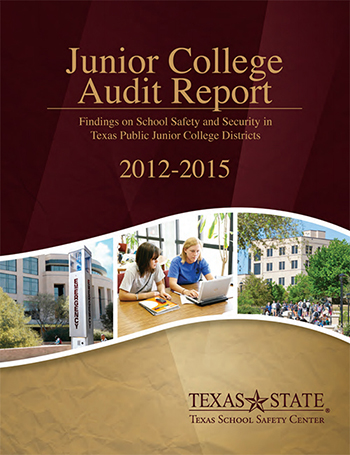
The purpose of the JCAR is to provide key results of the safety and security audits completed by Texas public junior college districts (herein referred to as junior college districts). In accordance with procedures developed by the Texas School Safety Center (TxSSC) or an equivalent public or private entity, the Texas Education Code requires junior college districts to complete safety and security audits of their facilities once every three years (§37.108 (4)(b)). Audits are conducted with the aim of identifying hazards, threats, and vulnerabilities that might pose a danger to life or property and/or may interfere with a safe, secure, and healthy environment that is conducive to higher education.
The TxSSC developed a model safety and security audit toolkit for junior college districts that provides guidelines showing proper audit procedures (§37.207 (1)). The audit toolkit for the 2012-2015 audit cycle included step-by-step instructions and recommendations for conducting audits, including a comprehensive audit checklist. The TxSSC captured key results of the safety and security audits completed by all Texas junior college districts. The data submitted by each junior college district were then aggregated into a statewide report for the public and the Texas State Legislature (§37.108 (4) (b)(c); (§37.207 (3)).
Methodology
The JCAR provides a summary of safety and security information for the reporting cycle September 1, 2012 through August 31, 2015. The report is comprised of self-reported data submitted by junior college districts in Texas. The TxSSC is authorized by the Texas Legislature to determine the method used to collect the audit results, as well as the type of data necessary for collection. Data was collected via the JCARtool, an online reporting application developed by the TxSSC.
“The purpose of the JCAR is to provide key results of the safety and security audits completed by Texas public junior college districts.”
The JCARtool contained two sections and approximately 20 questions regarding legislatively mandated safety and security audit procedures and practices. The first section of the questionnaire included demographic items and information about the audit process itself. The second section of the questionnaire included items related to the development and implementation of an emergency management program. Additional data were also collected to provide contextual information about the junior college districts. The TxSSC did not substantiate the data reported by junior college districts, and the accuracy of responses received from each district was presumed.
The JCARtool was made available to districts to begin reporting audit results on April 1, 2015. Correspondence with junior college district designees included six emails and several sets of phone calls until the JCARtool was closed on September 15, 2015. In total, all 50 junior college districts (n=50) reported audit results via the JCARtool, for a response rate of 100 percent.
Major Findings
- All 50 junior college districts (100 percent) reported that all campuses were included in the safety and security audit of their district.
- Forty of the 50 junior college districts (80 percent) indicated that they had reported the results of their safety and security audit to the Board of Trustees at the time of submission to the TxSSC.
- Forty-nine out of the 50 junior college districts (98 percent) reported that they had adopted a multi-hazard Emergency Operations Plan (EOP), and 46 of these 49 junior college districts (94 percent) reported that they reviewed their plan at least annually. Forty-eight of the 49 junior college districts (98 percent) reported that mitigation/prevention, preparedness, and response were included in their plans, while 47 of the 49 junior college districts (96 percent) reported that the recovery phase was also part of their plans.
- Forty-four out of the 50 junior college districts (88 percent) reported conducting emergency drills.
- Twenty-three out of 31 junior college districts for which the question was applicable (74 percent) reported that they had conducted and documented an after-action review following an emergency incident.
- All but one of the 50 junior college districts (98 percent) reported identifying key emergency management personnel, and 35 of those 49 junior college districts (71 percent) indicated that key personnel had received appropriate NIMS training. Additionally, emergency response training was made available to administrators in 44 junior college districts (88 percent), to faculty in 43 districts (86 percent), to staff in 43 districts (86 percent), and to students in 37 districts (74 percent).
- Forty-eight of the 50 junior college districts (96 percent) reported that they were in compliance with the Jeanne Clery Act.
- Thirty-two out of the 50 junior college districts (64 percent) reported that they provided residential facilities. Thirty-five junior college districts (70 percent) reported that they had their own police department, and 51 percent of those junior college districts reported employing nine or fewer commissioned peace officers.
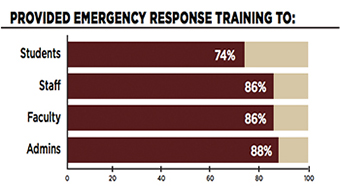
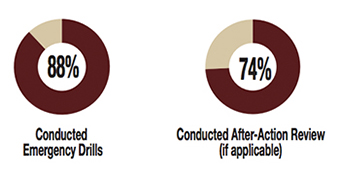
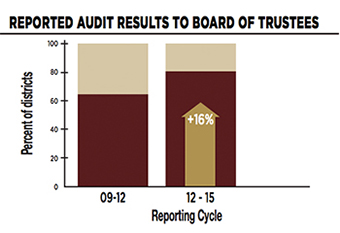
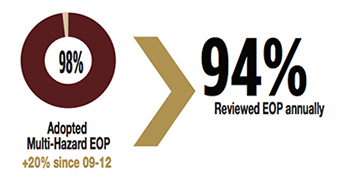
Recommendations
The findings from the 2012-2015 audit cycle identified four key areas to serve as recommendations for improvement toward the safety and security of junior college districts in Texas. These recommendations serve to assist junior college districts to prevent/mitigate, prepare for, respond to, and recover from potential hazards, and will aide in the overarching goals of safety and emergency management-saving lives and protecting property.
- Conduct annual review and update of the multi-hazard EOP, and coordinate with appropriate organizations, including the Department of State Health Services.
- Conduct drills and exercises as specified in the multi-hazard EOP.
- Provide opportunities for staff and students to receive safety and security training on topics such as the National Incident Management System (NIMS), the Incident Command System (ICS), the Jeanne Clery (Clery) Act, and emergency response procedures.
- Report audit results to the Board of Trustees per Texas Education Code (TEC) §37.108(c).